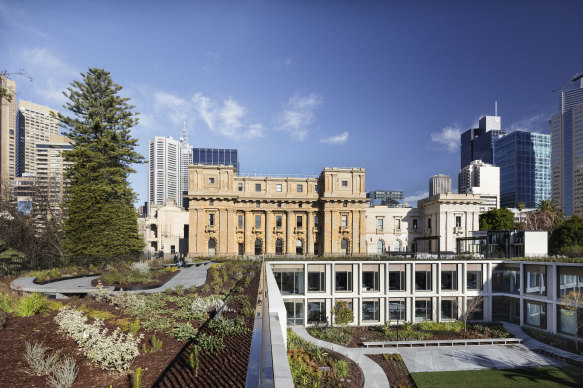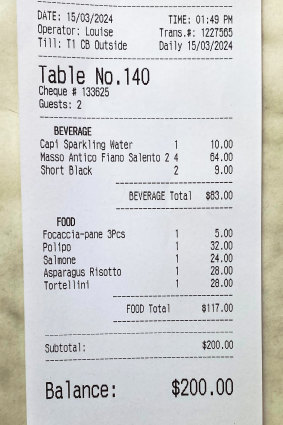source : the age
Peter Elliott reckons he’s not like other architects.
Where many a young architect dreams of making designer homes, Elliott is far more interested in “editing” the public world.
“You get to work on the great projects like designing pedestrian bridges, schools, university work … you feel like you’re really making a significant contribution to the urban fabric and to society generally,” he says.
Architect Peter Elliott.Credit: Chris Hopkins
“So to participate in that is just the best fun [rather than] worrying about what colour [bathroom] taps you’re going to have.”
It’s a gorgeous Friday afternoon; Bourke Street at the top end of the city is bathed in midday light and we’re sitting down to eat al fresco at Florentino Cellar Bar.
The streets have that cusp-of-the weekend thrum. It’s a choice time for a long lunch with the Australian architecture institution that is Peter John Elliott.
Most Melburnians at some point have driven past, walked over or been inside a Peter Elliott design — but many don’t know it.
From the Carlton Baths and the William Buckley Pedestrian footbridge at Barwon Heads, to the loud fluorescent architecture along the M80 Freeway and the vibrant nooks and crannies of RMIT’s city campus, Elliott’s touch is sprinkled across this city.
But it’s at the Florentino end of the CBD where Elliott’s biggest legacy project is taking shape – his magnum opus – the painstaking upgrading of Parliament House already under way for a decade.
“This is just really my favourite part of town,” he says. His favourite restaurants (Florentino among them) are here, as well as his favourite bookshops, his near 50-year-old architecture practice — and it’s a short stroll from home in Carlton.
Elliott has been coming to the Cellar Bar “forever”, he says, so The Age lets him navigate the menu: we start off sharing two delicate seafood entrees — octopus salad with potatoes, olives and capers, and a plate of cured salmon with orange and fennel — plus a glass each of Masso Antico Fiano Salento wine.

Cured salmon, orange, fennel and capers at Florentino Cellar Bar.Credit: Chris Hopkins
According to Elliott, cities and civic infrastructure reflects the society that builds and shapes them.
Now in his early 70s, he’s of a generation of activists, designers and thinkers whose contributions were shaped by the politics of their time.
Elliott, who grew up in the suburbs of the Wattle Park-Burwood area, missed the Vietnam draft as an 18-year-old and instead started his architecture degree at the University of Melbourne in 1968.
“It was an incredible time,” he says. “The Vietnam War was happening, [heritage] buildings were being demolished around the city. There was a lot going on.”
Elliot recalls university lecturers raving about the slum clearances that were happening concurrently in Melbourne’s inner suburbs, and the progressive activist types he was kicking around with in Fitzroy and Collingwood rubbed off on him.
That same cohort were catapulted into positions of authority in 1982 when John Cain brought Labor back into power after 27 years in the wilderness, with an agenda of serious social reform extended to architecture.
Elliott had graduated with Honours at 25 and immediately started his own practice, and jobs started coming in: childcare centres, small residential jobs and public housing projects, including renovating and retrofitting an old factory in Port Melbourne to become public housing units for families.
“It was a period of amazing new innovation, commissioning young architects, trying new ideas, it was fantastic,” he says. “That was a particularly interesting era that had its own momentum, politically, socially … there was a freshness of ideas.”
Projects that re-inhabit and revive old buildings have become the biggest hallmarks of Elliott’s career. In the industry, it’s called “adaptive reuse”; in layman’s speak, it’s the value in “fix ’em up, not knock ’em down”.

The tortellini di zucca.Credit: Chris Hopkins
We’ve vacuumed up the entrees, and it’s time for mains: Elliott goes for risotto con asparagi – asparagus with Fontina cheese — and I opt for tortellini stuffed with pumpkin, swimming in brown butter sauce. It’s Friday and it’s sunny, which warrants a second glass of vino for us both.
Elliott fizzes when talking about an upcoming project: a massive internal renovation of the South Melbourne Town Hall.
The classical Victorian-style hall has stood on Emerald Hill for 140 years but is in need of serious TLC after parts of the ceiling collapsed in 2018, triggering the fire system and causing serious water damage and drama for the long-term tenants, the Australian National Academy of Music.
“The building was originally as a civic building. It had a fire station, the town hall itself, council [chambers], a little post office … a courtroom,” he says. “We found one room, the old courtroom, that’s had 10 different uses from a bank chamber, a childcare centre, a courtroom, a music rehearsal room.”
After the mass council amalgamations under Liberal premier Jeff Kennet in the 1990s, many grand town halls in Melbourne’s inner suburbs were left without a purpose as councils consolidated into fewer facilities.
“You had all these older buildings that no one knew what do with … and they’ve struggled a bit,” Elliott says.
His task is to give the town hall new life as a permanent cultural venue. His team will oversee the $70 million fitout of a new 150-seat venue included in the building alongside the existing 250-seat hall, plus a new foyer bar and lounge, a commercial catering kitchen, and public terrace.
Transforming a heritage building into an A-grade music and performance venue is no easy task.
“This complex interrelationship between the shell of the existing building, the new requirements, the heritage issues, the acoustic issues, the theatre, the performers, the audience, all of these things have to be brought to bear.”
It’s the same patient work he is undertaking at Parliament House. After completing an award-winning, subterranean annexe in the Parliament House gardens in 2018, Elliot’s team is working through renovating the east wing of the original building which infamously was never properly completed.
Parliament was never designed to have MP offices, and it’s Elliott’s job to figure out how to install air-conditioning, digital security and other modern amenities into a building never designed to take them.
“The building was built in lots of little stages, so you uncover lots of little irregularities,” he says. “You discover cracking walls, or a moving wall or insufficient support for what you’re wanting to do. There’s just a lot of very careful work.”
Given his background in adaptive reuse and serious accolades for his work in public housing (a Member of the Order of Australia in 1987 for services to architecture, specifically public housing), I have to ask him what he makes of the Allan government’s public housing towers redevelopment plans.
Last September, then premier Daniel Andrews announced that all 44 pre-fabricated high-rise public housing towers would be progressively demolished and rebuilt over the next 30 years with triple the number of residents and a massive increase in private housing. It’s a controversial topic — now the subject of a class action lawsuit – in part because critics believe the government did not seriously entertain modifying the towers.
“Shocked, frankly, shocked,” Elliott says of his reaction to the announcement.
While some of the buildings may not be worth salvaging, others are in “still quite good nick” and have already had a lot of money spent on them, he says.
Elliot is dim on the rhetoric that “every tower must go”, and is concerned about the social impact of the mass relocations of vulnerable communities.

The Parliament of Victoria Members’ Annexe, completed in 2018, ended a century-and-a-half of makeshift offices for MPs and their staff.Credit: John Gollings
“Let’s just look at this intelligently. Let’s not just go, ‘we’re gonna get rid of them all’. It’s gonna be case by case – each one is going to have merits and issues.”
Elliott knows the architecture of the towers well. In fact, his practice alongside BKK architects won a Brumby government-run design competition in 2008 called “Tower Turnaround” to improve their sustainability, appearance and amenity.
Their winning concept can still be seen today on the side of the high-rise on Gordon Street in Footscray. Elliott and the team designed 1.2 metre x 3 metre bay-window lounge pods to extend the size of the small bedsits.
The pod replaced the external wall of an apartment, sliding in and extending the liveable space by 4.8 square metres.
“One prototype was built, and then nothing happened,” he says.
Innovative ideas being bogged down or lost in the bureaucracy of policy is something he’s seen a lot of in his time, he adds, whatever the colour of the politics of the day.
The lunchtime rush has slowed to a trickle, our plates are cleared and conversation turns away from talking shop and to his future life beyond work.

The receipt from Florentino Cellar Bar.Credit: Rachael Dexter
“I’ve never, ever worked weekends, it was always for family,” he says. “I’ve got six grandchildren. They’re all nearly all in their teenage years, which is great. I’m a keen cyclist so Saturday mornings, I’m always cycling. Sunday mornings [it’s] tennis. Cooking, travel reading – I’m an active kind of guy.
“I met an architect when I was very young and that’s what I decided I wanted to do when I was just 12 years old. My whole life has just been that trajectory and it’s difficult to give it up.
“And I have no particular reason to, other than – you know – I can’t go on forever.”
He’s pleased to hear younger people — via the newly emerged YIMBY movement – are taking an interest in local planning and design. “Generations have gone missing on this,” he says.

Architect Peter Elliott at lunch at Florentino Cellar Bar.Credit: Chris Hopkins
Having spent a huge portion of his career as an educator – he’s taught at Melbourne University, RMIT, Monash University and Papua New Guinea University of Technology – Elliot says he’s totally fine with the fact that none of his children followed him into architecture.
“One of the first things I learned when I started teaching … was how many young architecture students came from well-known architecture families, and how ill-suited they were or how unhappy they were.”
But then with a smile, and moment’s reflection, he clarifies he would be happy if one of his six grandchildren picks up the family trade.
“That’d be okay [if it] skips a generation,” he laughs.

